Australia So Much to See


Touring the inland areas of the Eyre Peninsula in South Australia
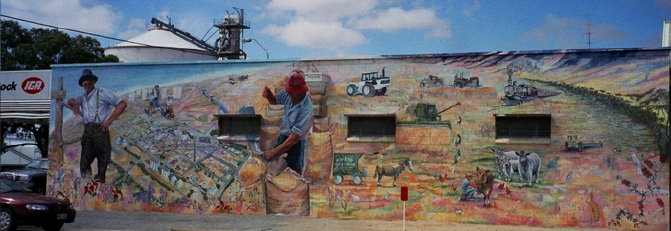
Inland on the Eyre Peninsula
We took trips to the hotter inland when it got too cool on the coast, and criss-crossed much of
the Eyre Peninsula.
At Wharminda Soaks, there is a huge flat camping area. Historic wells are marked near the entrance
to the campground. We walked for some time but did not find the gorge and rock formations. Walk trails were not marked.
A
lookout in the
When stopped on an old road alongside the Killiparu Conservation Park, I found this tiny clay pipe which I think is a burrowing land crayfish chimney.
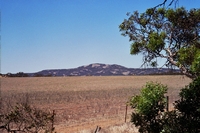
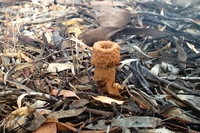
When travelling across the Eyre Peninsula on the Eyre Highway, the towns all have large wheat bins, and some places marked on
the map are little more than grain receival points. The Eyre Peninsula is one of the main wheat growing areas in
Goyder's Line as seen on the picture above was surveyed in 1865 by George Goyder to delineate the areas suitable for farming as distinct from those only suitable for pastoral grazing. The line delineates the areas which receive above and below 10 inches (254 millimetres) average annual rainfall. The vegetation type corresponds, with mallee scrub south of the line indicating country suitable for wheat cropping, whereas north of the line short vegetation such as saltbush generally suitable only for livestock grazing.
With
good rains in the 1870’s Goyder’s advice was disregarded, and in 1874 pastoral land was carved up and sold as farms heading well north
of the of the line – with wheat being grown as far away as Farina and even at Dalhousie. Towns were established, and over the
next ten years it appeared that Goyder had been wrong. After another good season in 1882, in 1883 and 1884 the worst drought
in twenty years occurred in
With different varieties of wheat being developed, on suitable soils cropping does take place north of Goyder’s line. At Kimba you will see the biggest receival bins of the Eyre. However farming north of the line is still risky. The farmers
of the
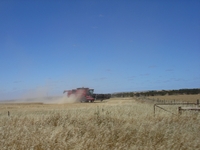
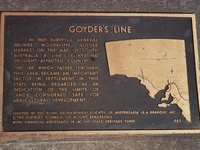
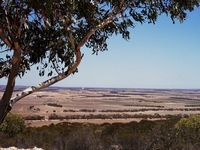
Cleve is the centre of an undulating farming area with richer soils in contrast to the limestone land of the west coast. An
old shop was decorated with colourful murals.
Centrally placed in the Eyre Peninsula is Lock, which has wheat bins and a colourful mural on the wall of the IGA general store.
Carappee Hill looks like a chunk of rocky road chocolate marshmallow. This highest point on the Eyre Peninsula is 495 metres above
sea level. We stayed at the Park campsite at the hill and wanted to climb to the top but there was no marked trail, nor any
indication to where to start the climb.